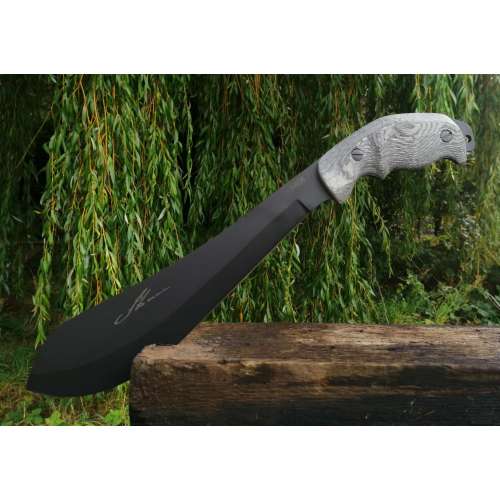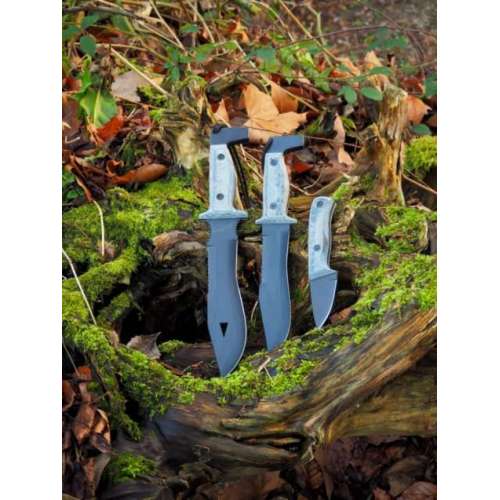Survival
Survival Knives
Historically, survival knives have existed in some form for more than a thousand years. In fact, even cavemen were discovered to have a survival knife in tow. Revolutionised by the infamous Jim Bowie, the survival knife is intended for survival purposes when lost in a wilderness environment.
The main aim of a survival knife is...
Survival Knives
Historically, survival knives have existed in some form for more than a thousand years. In fact, even cavemen were discovered to have a survival knife in tow. Revolutionised by the infamous Jim Bowie, the survival knife is intended for survival purposes when lost in a wilderness environment.
The main aim of a survival knife is to provide the user with one tool that can be as useful for cutting branches down as it is for defending against or attacking any wild animals. Nowadays, survival knives are frequently issued by military units and used by hunters, hikers and other outdoor sports enthusiasts.
At Samuel Staniforth, we offer an extensive range of survival knives, from Mel Parry’s ultimate survival blade to John "Lofty" Wiseman’s "Signature" Survival Tool. Crafted from the most sturdy and reliable materials, our survival knives are perfect for making traps, building huts and chopping wood. In other words, they are extremely versatile and can be used for various purposes.
The History Behind Survival Knives
The survival knife’s history began and its story continues in the same place, the wilderness. These tools have existed in some form or another since the dawn of time when cavemen forged knives from shards of flint, obsidian and other rock material.
Whilst their knives were forged from different materials, cavemen likely used these survival knives for many of the same reasons that we use them for today: hunting, trapping, skinning and cleaning wild game, woodcutting and carving.
In the 1830s, the notorious Jim Bowie revolutionised the survival knife. This legendary pioneer is responsible for designing the Bowie Knife, a widely recognisable fixed-blade knife created with hunting in mind. The knife featured a large, wide blade, cross guard, and a false edge cut on both sides. Bowie’s own exploits would make this knife famous, as he was rarely seen without his knife firmly attached to his person.
It was not until the 20th century when survival knives underwent another metamorphosis. A man named Webster L. Marble introduced heavier blades, cross-guards and pommels to formulate a more modern design. By the time WWII came around, survival knives replaced butcher knives as the standard for US soldiers. Survival knives were also issued in the Vietnam War to troops and continue to be an option soldiers can select to carry even now.
Characteristics of a Survival Knife
Learn more about the specific characteristics of a survival knife below:
1. Full-Tang
When you are selecting your survival knife, it is imperative that the knife is full tang. The term, full tang, means the knife blade and handle tang are formed from a singular piece of steel. The tang is the part of the knife upon which the handle scales are attached.
2. Blade Thickness: 3/16-1/4 inch
The next characteristic of a good survival knife involves blade thickness. A good survival knife needs a blade thickness between 3/16 of an inch to 1/4 of an inch, which is approximately 4mm to 6mm. This provides a solid and durable blade that will last if you take care of it. The blade thickness is important if using the knife for prying things apart.
3. Blade Length: 4.5-6 inches
A third characteristic of a good and reliable survival knife is blade length. There are some experts that recommend that a survival or bushcraft knife should have a blade length of no less than five inches.
If you can, avoid selecting a survival knife with an extremely long blade. A knife blade beyond six or seven inches is probably going to be too cumbersome to wield when building traps or skinning a squirrel.
4. Blade Materials: D2 or 1095 High Carbon Steel
Another characteristic of a quality survival knife is the steel used.
There is almost universal agreement that high carbon tool steel is the optimum material for a knife blade. D2 and 1095 steels are the most favourable tool steels for the blade construction of a survival knife. These blade steels are ideal for those who are spending a lot of time in the field such as hunters or bushcrafters. They are easy to sharpen and hold an edge well.
However, a good blade steel to consider is stainless steel if there is only an occasional excursion to the outdoors. This means that it is easy to keep corrosion and rust from building up on the blade or handle. For example, many of the top game processing knives feature a stainless steel blade. A stainless steel outdoor knife may be a consideration for only a weekend outing on the campgrounds, cabin, or favourite fishing hole.
5. Blade Spine: 90° Spine
When choosing your survival knife, you want to make sure that it is ground to a 90° edge. This kind of edge is useful in the field as it allows a person to use the spine of the knife to scrape bark from a tree for tinder and strike a ferro rod when making a fire.
6. Blade Grind: Scandinavian or Flat
The final characteristic of an excellent survival knife is the blade grind. There are two common blade grinds that one will find on a quality survival knife, a Scandinavian grind and a flat grind. Of the two, the Scandinavian grid tends to be the most popular. The reason why these two grinds are popular on survival knives is that they are the easiest types of blades to sharpen in the wilderness.
Other blade grinds sometimes require special tools or expertise to sharpen. Thus, most of the high quality, and, expensive bushcraft or survival knives will feature these blade grinds.
Survival Knives FAQs
What Are Survival Knives Used For?
Survival knives can be used for many different tasks, including:
Building Fires - Survival knives are great for gathering and preparing firewood. You can use a survival knife to shave bark off a tree, chop dead branches, or take down a small tree. You can also use it to split wood into kindling or shave moss off a tree to get a small fire started.
General Cutting - The primary purpose of a knife is to cut. The ideal survival knife should have a blade that can cut rope and any other material you might be working with, whether you’re building a shelter, hacking through brush or vines, or cutting up and cooking the game you trapped for dinner.
Prying - A survival knife with a sturdy tip can easily pry something open or apart.
Batoning - If you find yourself stuck in wet conditions and the wood you’ve gathered just won’t burn, you can use a survival knife with a baton to split wood.
Preparing Food - A wilderness survival knife can be used for tasks related to preparing food — dressing game, skinning and filleting fish, cutting fruits and vegetables, etc.
Building Shelter - For this, you’ll need a survival knife that can chop off tree limbs to make poles or cut leafy branches for overhead cover. If you have some gear, you can use it to cut rope or drive tent stakes.
Foraging for Food - One survival knife use you might not consider initially is digging. If you’re really desperate for food, you might need to dig up and eat roots from a plant or dig up a ground squirrel.
Fishing - You can use a survival knife for cutting lines or cleaning out a fish you need to cook and eat.
First Aid - Survival often involves some sort of first aid. You can use a survival knife for basic first-aid tasks, such as cutting bandages and clothing or removing splinters and stingers.
Finding Water - On freezing days and nights, you can use a survival knife to chop a hole in ice to access fresh water or fish.
What Are The Different Types Of Survival Knives?
When selecting a knife for survival situations, there are two main types: fixed-blade and folding knives. Each type has unique features and benefits that suit different survival scenarios.
Fixed Blade Knives - Fixed-blade knives are typically more durable and sturdy than folding knives, making them ideal for heavy-duty tasks such as chopping wood, hunting and building shelter. Their simple design makes them easier to clean and maintain. They also tend to have a comfortable and ergonomic handle for easy gripping and use.
Folding Knives - Folding knives are typically smaller and more compact than fixed-blade knives, making them ideal for situations where portability is a concern. They are also easier to carry around in a pocket or backpack. Folding knives are best suited for cutting rope or opening packages rather than heavy-duty tasks.
How Do I Maintain My Survival Knife?
Here are the main factors you need to consider in order to maintain your survival knife:
Sharpening: A sharp knife is essential in survival situations. Sharpen your knife regularly using a sharpening stone or a sharpening rod.
Cleaning: Clean your knife after every use to prevent rust and corrosion. Use a cloth to wipe the blade, and apply oil to prevent rust.
Lubrication: Apply oil or lubricant to the hinge of folding knives to prevent them from getting stuck.
How To Use Your Survival Knife Safely?
In a survival situation, a single mistake when using a knife could result in severe injury. Therefore, it is crucial to understand safety considerations when using survival knives.
When using a knife in a survival situation, it is essential to follow proper safety techniques. These include:
Keeping the knife sharp to reduce the risk of slipping.
Holding the knife with a firm grip and using it with controlled movements.
Always pointing the knife away from the body.
Never throw a knife, as it can be hazardous.
What is the Difference Between Survival Knives and Bushcraft Knives?
First things first, it’s important to note that Bushcraft and Survival knives are closely related, and some people use the terms interchangeably. However, there are some main differences between the two types of knives:
Survival Knife | Bushcraft Knife |
Longer and broader blade | Smaller blade and often have a Scandi edge |
Better for heavier tasks (e.g. batoning) | Classic and minimalist appearance |
Surviving in nature (escaping as quickly as possible) | Intentionally living in nature |
To conclude, it is a matter of personal preference regarding which type of knife you select. Our advice is to try and test them for yourself. This is the best way to know which knife is going to suit you and the tasks you will be carrying out.
Parry Hiker Parry Hiker
The Parry Blade and Hiker are simply the best ultimate Survival Knives - the result of a unique collaboration between Mel Parry and Scorpion Knives. The Parry Blade and Hiker are simply...
(subject to availability )8.5" - John "Lofty" Wiseman - "Signature" Survival Tool 8.5" - John "Lofty" Wiseman - "Signature"...
Survival Knife Designed by Lofty Wiseman. Survival Knife Designed by Lofty...
(subject to availability )
Categories
Wishlist
Information
New products
-

16" Double Handled Cheese Knife / Cake Knife / Pizza Knife
16 Inch Double Handle Cheese / Cake knife / Pizza knife X50 Stainless...
£ 60.00
Specials
-

5 Piece Set - Coloured Curly Birch
£ 296.00 -20% £ 370.00










